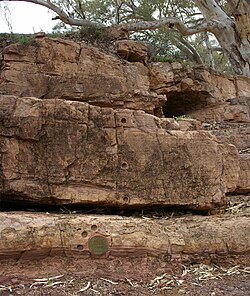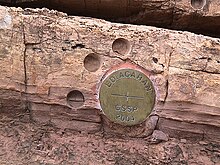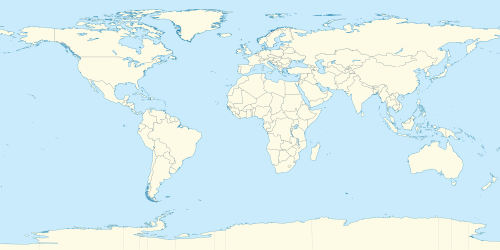전역 경계 성층형 단면 및 점
Global Boundary Stratotype Section and PointGSSP(Global Boundary Stratotype Section and Point)는 지질학적 시간 척도에서 단계의 하한을 정의하는 지층학 섹션의 참조점에 대해 국제적으로 합의된 것이다.GSSP를 정의하기 위한 노력은 국제지질과학연합의 일부인 성층학 국제위원회에 의해 수행된다.전부는 아니지만 대부분의 GSSP는 고생물학적 변화에 기반을 두고 있다.따라서 GSSP는 보통 서로 다른 동물 단계 간의 천이 관점에서 설명되지만 GSSP보다 훨씬 더 많은 동물 단계가 설명되었습니다.GSSP 정의 노력은 1977년에 시작되었다.2022년 현재 GSSP가 필요한 101개 단계 중 77개 단계가 승인된 GSSP를 [1]보유하고 있습니다.
규칙.
지질학 섹션은 ICS에 의해 GSSP로 적응하기 위한 일련의 기준을 충족해야 합니다.다음 목록은 기준을 [2][3]요약한 것입니다.
- GSSP는 지질 단계의 하한을 정의해야 한다.
- 하한은 1차 표식(일반적으로 화석 종의 첫 출현 기준)을 사용하여 정의해야 한다.
- 아웃 크롭은 적절한 두께를 가져야 합니다.
- 침강은 면의 변화 없이 연속되어야 합니다.
- 출구는 구조 및 퇴적 이동과 변성 작용에 의해 영향을 받지 않아야 한다.
- 출구는 연구에 이용할 수 있어야 하고 자유롭게 접근할 수 있어야 한다.
- 여기에는 출구가 신속하게 방문할 수 있는 곳(국제 공항 및 좋은 도로), 양호한 상태(이상적 국가 보호구역), 접근 가능한 지형, 반복적인 샘플 채취가 가능하고 모든 국적의 연구자에게 개방될 수 있는 광범위한 곳에 위치해야 한다는 것이 포함된다.
합의된 글로벌 경계 성층형 섹션 및 포인트
뉴펀들랜드 포춘 헤드의 선캄브리아-캄브리아 경계 GSSP는 전형적인 GSSP입니다.포장도로로 접근할 수 있으며 자연보호구역으로 지정되어 있다.선캄브리아식 침대부터 캄브리아식 침대까지 연속 섹션이 제공됩니다.이 경계는 전 세계적으로 발견된 복잡한 미량 화석인 Treptichnus pedum의 첫 출현으로 정해졌습니다.Fortune Head GSSP는 떠내려가거나 겹쳐지는 일은 거의 없습니다.그럼에도 불구하고 Treptichnus pedum은 모든 캄브리아기 배열에서 발견되는 것이 아니기 때문에 표식화석으로는 이상적이지 않으며, 모든 노출에서 동일한 수준에서 발견된다고 확신할 수 없다.사실, 경계 마커로서의 값을 더욱 잠식하면서, 그 이후로 GSSP [5]아래의 4m 층에서 식별되었다.그러나, 선호할 만한 다른 화석은 알려져 있지 않다.Fortune Head의 경계에는 방사선 측정 가능한 침대가 없지만, 근처의 유사한 침대는 경계보다 약간 위에 있다.이러한 요인들로 인해 일부 지질학자들은[who?] 이 GSSP를 [citation needed]재할당할 필요가 있다고 제안했습니다.
일단 GSSP 경계가 합의되면, 미래의 지질학자들을 위한 정확한 경계를 표시하기 위해 지질학 부분에 "황금 스파이크"가 몰린다(실제로는 " 스파이크"가 황금 스파이크일 필요도 없고 실제 스파이크일 필요도 없다).1972년 체코 수초마시 마을 북동쪽에 있는 클론크라는 지역에서 실루리아-데보니아 경계를 청동 명판으로 식별함으로써 첫 번째 층서 경계선이 정의되었다.GSSP는 골든 스파이크로 불리기도 합니다.
세계 표준 층서 시대
GSSP를 정의하는 것은 잘 보존된 지질구간을 찾아 주요 이벤트를 식별하는 것에 달려 있기 때문에 이 작업은 시간이 오래 걸릴수록 더욱 어려워집니다.6억 3천만 년 전에 지질학적 시간 척도의 경계는 "지구 표준 성층학 시대"라고 알려진 고정된 날짜를 참조함으로써 정의되었습니다.
「 」를 참조해 주세요.
| 크로노스트라티그래피에서 암석(지층)의 세그먼트 | 지질 연대표에서의 시간 범위 | 에 대한 주의사항 지질 연대 단위 |
|---|---|---|
| 언오템 | 언 | 총 4개, 5억 년 이상 |
| 에라템 | 시대 | 10개의 정의, 수억 년 |
| 시스템. | 기간 | 22개의 정의, 수천 년에서 1억 년 |
| 시리즈 | 에폭 | 34 정의, 수천만 년 |
| 단계. | 나이 | 99 정의, 수백만 년 |
| 크로노존 | 시간 | ICS 타임스케일에서 사용되지 않는 연령의 하위 구분 |
메모들
- ^ "International Chronostratigraphic Chart 2020". International Commission on Stratigraphy. Retrieved 20 July 2021.
- ^ Remane, J.; M. G. Bassett; J. W. Cowie; K.H. Gohrbandt; H.R. Lane; O. Michelsen; Wang Naiwen (1996). "Guidelines for the establishment of global chronostratigraphic standards by the International Commission on Stratigraphy (ICS)" (PDF). Episodes. 19: 77–81. doi:10.18814/epiiugs/1996/v19i3/007.
- ^ "GSSP Rules". Geologic Timescale Foundation. Retrieved 28 November 2012.
- ^ "GSSP Table - All Periods". Geologic Timescale Foundation. Retrieved 29 November 2012.
- ^ Gehling, J.; Jensen, S. R.; Droser, M.; Myrow, P.; Narbonne, G. (March 2001). "Burrowing below the basal Cambrian GSSP, Fortune Head, Newfoundland". Geological Magazine. 138 (2): 213–218. Bibcode:2001GeoM..138..213G. doi:10.1017/S001675680100509X.
- ^ 를 클릭합니다Cohen, K.M.; Finney, S.; Gibbard, P.L. (2015), International Chronostratigraphic Chart (PDF), International Commission on Stratigraphy.
레퍼런스
- Hedberg, H.D., (편집자), 국제 지층학 가이드: 층서 분류, 용어 및 절차에 대한 가이드, New York, John Wiley and Sons, 1976[ISBN missing]
- 국제 층서 위원회 국제 층서 차트
- ICS Stratigraphic Information Subcommission에서 승인한 각 GSSP 페이지 포함 GSSP 테이블
- 미국 국립공원국
- 워싱턴 주립 대학교
- 웹 지질 타임머신
- Eon 또는 Eon, Math Words – 알파벳 색인
외부 링크
- Global Boundary Stratype Section and Point(GSSP; 글로벌 경계 스트라토타입 섹션 및 포인트): 개요
- Global Boundary Stratotype Sections and Points(GSSP; 글로벌 경계 스트라토타입 섹션 및 포인트): 그래프
- Global Boundary Stratype Sections and Points(GSSP; 글로벌 경계 스트라토타입 섹션 및 포인트) 표와 각 요약 페이지 링크: 차트
- GSSP 및 대륙 이동 3D 뷰
- 화석 기록과 비교한 지질학적 기간을 나타내는 지오타임 차트 – 일반인(GSSP가 아님)의 연대와 분류를 다룬다.



